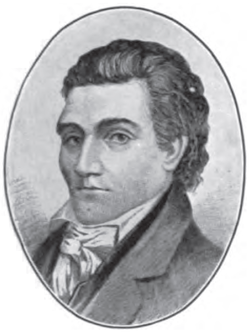Martin Baum

Martin Baum (15 June 1765 in Hagerstown, Maryland – 14 December 1831 in Cincinnati, Ohio [1]) was an American businessman and politician.
The son of German immigrants Jacob Baum and Magdalena Elizabeth Kershner, Baum fought with General Anthony Wayne at the Battle of Fallen Timbers.
After settling in Cincinnati, Baum became active in civic affairs, and was elected mayor in 1807 and 1812.[2][3] Through his agents in Baltimore, New Orleans and Philadelphia, Baum attracted a great number of German immigrants to work in his various enterprises — steamboats, a sugar refinery, a foundry and real estate.[4] Baum founded the Western Museum, was active in the first public library 1802, and was one of the main pillars of the First Presbyterian Church. He married Anna Somerville Wallace in 1804.
He bought the 9-acre (36,000 m2) property on Pike Street in 1812, to build his home. Baum completed construction about 1820, the building, once lived in by Nicholas Longworth (the first) and David Sinton is now the Taft Museum. The building is the best example of the Federal style in Cincinnati. Baum was caught in the financial upheaval of 1819-20, he was eventually forced to deed his home back to the Bank of the United States in 1825.
Baum died during an influenza epidemic.[5] He was buried in the First Presbyterian Ground. On 6 June 1853 his body was moved to Spring Grove Cemetery.
References and notes
- ↑ "Martin Baum" findagrave.com 7 November 2010
- ↑ Greve, Charles Theodore (1904). Centennial history of Cincinnati and representative citizens 1. Chicago: Biographical Publishing Company. p. 438.
- ↑ Goss, Charles Fredric (1912). Cincinnati, the Queen City, 1788-1912 1. Cincinnati: S J Clarke Publishing Company. p. 96.
- ↑ "At the beginning of the 19th century, German immigrants were about 5% of Cincinnati's population. By the time of the American Civil War, Germans were one-third of the population, and by the end of the century, about 60% of Cincinnati's citizens were of German heritage. So not only did German immigrants influence society in Cincinnati, the changed it completely."
- ↑ Clark, S. J. (1912). "Cincinnati, the Queen City, 1788-1912, Volume 2". The S. J. Clarke Publishing Company. p. 12. Retrieved 2013-05-20.
| Political offices | ||
|---|---|---|
| Preceded by John S. Gano |
Mayor of Cincinnati 1807 |
Succeeded by Daniel Symmes |
| Preceded by James Findlay |
Mayor of Cincinnati 1812 |
Succeeded by William Stanley |